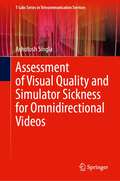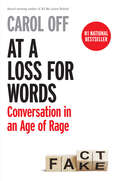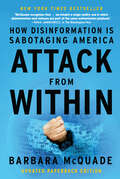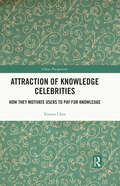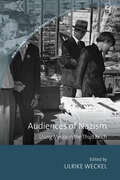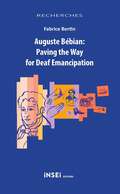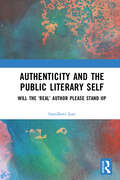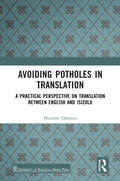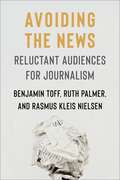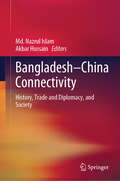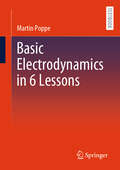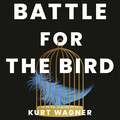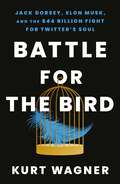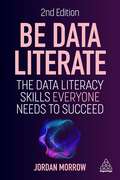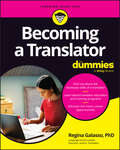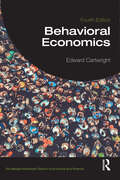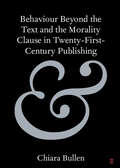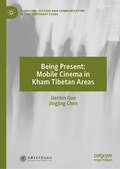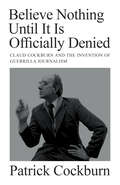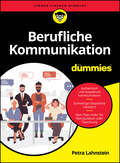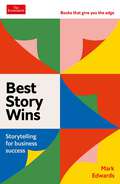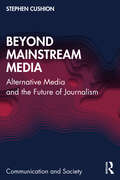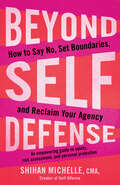- Table View
- List View
Assessment of Visual Quality and Simulator Sickness for Omnidirectional Videos (T-Labs Series in Telecommunication Services)
by Ashutosh SinglaThis book presents extensive research on the quality of 360° video perceived by users with HMDs. The book aims to develop a set of standard guidelines for the systematic visual quality assessment of 360° videos. Firstly, conventional subjective test methods such as Absolute Category Rating (ACR) and Double Stimulus Impairment Scale (DSIS) are applied to evaluate video quality, alongside the Modified ACR (M-ACR) method newly proposed. Building on the reliability and general applicability of the procedure across different tests, a methodological framework for 360° video quality assessment is then presented. The author also analyzes simulator sickness to investigate the impact of different influencing factors. The insights gained on simulator sickness related to 360° video contribute to a better understanding of this particular use case of VR and can help to improve comfort among users by suggesting improvements in the technical specifications of 360° video and HMD technology and thus improving QoE.
At a Loss for Words: Conversation in the Age of Rage
by Carol OffAN INSTANT #1 NATIONAL BESTSELLER Award-winning author and broadcast journalist Carol Off digs deep into six words whose meanings have been distorted and weaponized in recent years—including democracy, freedom and truth—and asks whether we can reclaim their value.As co-host of CBC Radio's As It Happens, Carol Off spent a decade and a half talking to people in the news five nights a week. On top of her stellar writing and reporting career, those 25,000 interviews have given her a unique vantage point on the crucial subject at the heart of her new book—how, in these polarizing years, words that used to define civil society and social justice are being put to work for a completely different political agenda. Or they are being bleached of their meaning as the values they represent are mocked and distorted. As Off writes, &“If our language doesn&’t have a means to express an idea, then the idea itself is gone—even the range of thought is diminished.&” And, as she argues, that&’s a dangerous loss.In six, wide-ranging chapters, Off explores the mutating meanings and the changing political impact of her six chosen words—freedom, democracy, truth, woke, choice and taxes—unpacking the forces, from right and left, that have altered them beyond recognition. She also shows what happens when we lose our shared political vocabulary: we stop being able to hear each other, let alone speak with each other in meaningful ways. This means we stop being able to reckon with the complexity of the crises we face, leaving us prey to conspiracy theories, autocrats and the machinations of greed. At a Loss for Words is both an elegy and a call to arms.
Attack from Within: How Disinformation Is Sabotaging America
by Barbara McQuadeA NEW YORK TIMES BESTSELLERAn urgent, comprehensive explanation of the ways disinformation is impacting democracy, and practical solutions that can be pursued to strengthen the public, media, and truth-based politicsMSNBC's legal expert breaks down the ways disinformation has become a tool to drive voters to extremes, disempower our legal structures, and consolidate power in the hands of the few."One of the most acute observers of our time shares . . . a compelling work about a challenge that—left unexamined and left unchecked—could undermine our democracy." —Eric H. Holder Jr, 82nd Attorney General of the United StatesAmerican society is more polarized than ever before. We are strategically being pushed apart by disinformation—the deliberate spreading of lies disguised as truth—and it comes at us from all sides: opportunists on the far right, Russian misinformed social media influencers, among others. It's endangering our democracy and causing havoc in our electoral system, schools, hospitals, workplaces, and in our Capitol. Advances in technology including rapid developments in artificial intelligence threaten to make the problems even worse by amplifying false claims and manufacturing credibility.In Attack from Within, legal scholar and analyst Barbara McQuade, shows us how to identify the ways disinformation is seeping into all facets of our society and how we can fight against it. The book includes: The authoritarian playbook: a brief history of disinformation from Mussolini and Hitler to Bolsonaro and Trump, chronicles the ways in which authoritarians have used disinformation to seize and retain power.Disinformation tactics—like demonizing the other, seducing with nostalgia, silencing critics, muzzling the media, condemning the courts; stoking violence—and reasons why they work.An explanation of why America is particularly vulnerable to disinformation and how it exploits our First Amendment Freedoms, sparks threats and violence, and destabilizes social structures.Real, accessible solutions for countering disinformation and maintaining the rule of law such as making domestic terrorism a federal crime, increasing media literacy in schools, criminalizing doxxing, and much more.Disinformation is designed to evoke a strong emotional response to push us toward more extreme views, unable to find common ground with others. The false claims that led to the breathtaking attack on our Capitol in 2021 may have been only a dress rehearsal. Attack from Within shows us how to prevent it from happening again, thus preserving our country&’s hard-won democracy.
Attraction of Knowledge Celebrities: How They Motivate Users to Pay for Knowledge (China Perspectives)
by Xiaoyu ChenThis book examines the phenomenon of knowledge celebrities, an emerging group of social media influencers who produce and sell knowledge products online. Its primary goal is to investigate the reasons and strategies behind their ability to attract users and persuade them to purchase knowledge products on digital platforms. With the increasing demand for high-quality content from online users, various platforms have emerged as pay-for-knowledge platforms, allowing knowledge celebrities to monetize their expertise. This book draws on theoretical frameworks from information science, communication and management to provide insights into this phenomenon and to examine the practices and individuals involved. Building on existing scholarship and analyzing case studies in China, this book presents the background, basic concepts and understanding of knowledge celebrities. It then explores the three key factors that contribute to the attractiveness of knowledge celebrities, as well as the motivations and mechanisms behind pay-for-knowledge practices. Finally, the book offers a glimpse into the future landscape of knowledge celebrities and pay-for-knowledge platforms. The book will be valuable to scholars, students, and practitioners in information, communication and media studies. In particular, it will appeal to those interested in topics such as knowledge celebrities, the creator economy and knowledge management.
Audiences of Nazism: Using Media in the Third Reich (New German Historical Perspectives #13)
by Ulrike WeckelThrough its focus on audiences and their reception of media in Nazi Germany, Audiences of Nazism inverts the typical top-down perspective employed in studies that concentrate on the regime’s regulation of media and propaganda. It thereby sheds new light on the complex character of the period’s media, their uses, and the scope for audience interpretation. Contributors investigate how consumers either appropriated or ignored certain messages of Nazi propaganda, and how some even participated in its production. The authors ground their studies on novel historical sources, including private diaries and letters, photographs and films, and concert programs, which demonstrate, amongst other things, how audiences interpreted and responded to regulated news, Nazi Party rallies, and the regime’s denunciation of modern works of art as ‘degenerate.’
Auguste Bébian: Paving the Way for Deaf Emancipation
by Fabrice BertinPublished in French and English by INSEI Editions, Suresnes, France. English edition distributed throughout the world by Gallaudet University Press. To some, he is a mythical figure; to others, he is unknown. Auguste Bébian (1789-1839) reflects society’s ambivalence toward Deaf history: sometimes recognized, often ignored. In the wake of Abbé de l’Épée, whose name is remembered in posterity and who demonstrated that the large-scale education of Deaf people was possible, Auguste Bébian was nonetheless a key player in an unprecedented upheaval, which in many ways went beyond the educational sphere. The goal of this research on Auguste Bébian, combining biographical elements and analysis of his thinking in unprecedented ways, is not to deconstruct the myth, but rather to decipher the messages it conveys, and to understand what it tells us, indirectly, about the Deaf experience. Born in 1789 in Guadeloupe, part of the French West Indies, it was on the other side of the Atlantic Ocean, in France, that Auguste Bébian fulfilled most of his destiny. While living at the National Institution for the Deaf in Paris at the beginning of the 19th century, his daily contact with the young students made him the first known hearing person in France to achieve true mastery of sign language, the natural language of Deaf people, and a deep understanding of its inherent culture. On becoming a teacher, he constantly defended the use of sign language as a linguistic system in its own right in order to awaken the intelligence of Deaf children, to whom “we pay no more attention than to the sunlight that shines on us every day.” His numerous publications display a level of modernity rarely seen before or since. This biographical and historical study shows how the passion evinced by Auguste Bébian was a crucial link in the chain of events that led to the emancipation of Deaf people.
Authenticity and the Public Literary Self: Will The ‘Real’ Author Please Stand Up
by Sreedhevi IyerThis is the first book-length study on how authors of color present themselves in public literary discourse. The study utilizes data obtained from and around exemplary empirical case study participants – Junot Diaz, Madeleine Thien, and Mohsin Hamid. Relevant data includes the case study authors’ Twitter usage and the impact of the digital sphere in author self-presentation. Dr Iyer employs a combined theoretical framework of discourse analysis and interactional sociolinguistics, with an awareness of literary and creative writing studies. The theoretical approach uses four metapragmatic stereotypes regarding what constitutes an ‘authentic’ author. The theoretical approach and metapragmatic stereotype form an evaluative framework that can be applied on diverse data to replicate findings.The study originated from the author’s own exposure to prevailing literary discourse through public engagements as a writer. She became aware of the problematic nature of an author’s public self-presentation, with a requirement to ‘be yourself’. Each celebrity author of color faces a paradoxical positioning within literary discourse as a result of that requirement. Through her study, Dr Iyer sought to discover how authors of color negotiate themselves in public spheres, including digital social media platforms, in order to accomplish ‘authenticity’ discursively.This book is ideal for learners and practitioners in creative writing who are seeking strategies for self-presentation as published authors. It is also valuable for researchers in discourse analysis, including literary discourse and social media discourse, providing an empirical means of evaluating ‘authenticity’ as understood in contemporary times.
Avoiding Potholes in Translation: A Practical Perspective on Translation between English and isiZulu
by Phindile DlaminiThis book is a comprehensive introduction to translation studies between English and isiZulu. It incorporates crucial concepts for understanding the basics of translation within a South African language context and lays a foundation for further studies in translation. The book's content coverage, while broad, is also in-depth, and it skillfully integrates examples from varied types of texts. The practical and accessible style makes it both engaging and informative. The diverse examples illustrate not only the technicalities of translation as a process, but the vivid dynamics brought about by the fact that the languages involved in the translation process belong to different language families. The use of these examples for almost every aspect of translation explained makes this book unique and valuable to translation scholars and practitioners alike. Even though the book uses cases from the isiZulu language, it is an applicable reference for translation scholars and practitioners working with different indigenous languages of South Africa. Print edition not for sale in Sub Saharan Africa.
Avoiding the News: Reluctant Audiences for Journalism (Reuters Institute Global Journalism Series)
by Rasmus Kleis Nielsen Ruth Palmer Benjamin ToffA small but growing number of people in many countries consistently avoid the news. They feel they do not have time for it, believe it is not worth the effort, find it irrelevant or emotionally draining, or do not trust the media, among other reasons. Why and how do people circumvent news? Which groups are more and less reluctant to follow the news? In what ways is news avoidance a problem—for individuals, for the news industry, for society—and how can it be addressed?This groundbreaking book explains why and how so many people consume little or no news despite unprecedented abundance and ease of access. Drawing on interviews in Spain, the United Kingdom, and the United States as well as extensive survey data, Avoiding the News examines how people who tune out traditional media get information and explores their “folk theories” about how news organizations work. The authors argue that news avoidance is about not only content but also identity, ideologies, and infrastructures: who people are, what they believe, and how news does or does not fit into their everyday lives. Because news avoidance is most common among disadvantaged groups, it threatens to exacerbate existing inequalities by tilting mainstream journalism even further toward privileged audiences. Ultimately, this book shows, persuading news-averse audiences of the value of journalism is not simply a matter of adjusting coverage but requires a deeper, more empathetic understanding of people’s relationships with news across social, political, and technological boundaries.
Bangladesh–China Connectivity: History, Trade and Diplomacy, and Society
by Md. Nazrul Islam Akbar HussainThis book adopts an interdisciplinary social science approach. It includes original research papers on Bangladesh-China’s connectivity to archaeology, history, religion, traditional Chinese medicine, language and literature, women and gender, diplomacy and strategic relations, bilateral business and trade, and the Belt and Road Initiative (BRI). Most of the existing literature perceives bilateral and regional connectivity from economic and strategic points of view and emphasizes financial and political profit-loss and integration. This book combines the archeological and cultural issues from history and diplomacy, and soft power from the present. The content of this book has a broader scope and is divided into six parts including background and introduction; archeology, history, and religion; business and trade; diplomacy and geo-strategy; traditional Chinese medicine; language and literature; and society, culture, and gender. This book is particularly designed for undergraduate and postgraduate students, researchers, academics, journalists, and strategic think tanks from broader humanities and social sciences backgrounds including, history, archeology, religious studies, philosophy, sociology, anthropology, political sciences, international relations, economics, environmental studies, language and literary studies, gender studies, health studies, and business.
Barrierefrei kommunizieren für Unternehmen: Wie Sie die Anforderungen des Barrierefreiheitsstärkungsgesetzes effizient umsetzen (essentials)
by Gabriele HorcherDieses essential zeigt, welche Bedeutung digitale Barrierefreiheit für die Unternehmenskommunikation hat und wie diese die Ansprache Verbrauchern verändern wird. Das ab dem 28. Juni 2025 geltende Barrierefreiheitsstärkungsgesetz (BFSG) wird zum Beschleuniger dieser Entwicklung, mit der sich künftig viele Unternehmen auseinandersetzen müssen. Die renommierte Kommunikationswissenschaftlerin Gabriele Horcher zeigt auf, wie die neuen gesetzlichen Anforderungen effizient umgesetzt werden können und wie künstliche Intelligenz dabei helfen kann. Darüber hinaus stellt sie Strategien für Berater und Dienstleister vor, die ihre Kunden optimal unterstützen wollen.Ein auf den Punkt geschriebenes Buch für Entscheidungsträger, Kommunikations-, Compliance- und E-Commerce-Verantwortliche, die alles Wichtige über die spezifischen Herausforderungen der digitalen Barrierefreiheit erfahren und von den neuen Chancen profitieren wollen.
Basic Electrodynamics in 6 Lessons
by Martin PoppeThis book explains why there are different variants of Maxwell's equations and the physical meaning of the quantities they contain. It also shows how the equations for static electric and magnetic potentials are derived from Maxwell's equations. Matter exposed to the field is an integral part of the discussion. Multipole developments are justified and derived. Furthermore, the potential for simplification in formulating dynamical theory as gauge field theory is explained. The laws of optics are derived from those of electrodynamics. Justifications are provided for quasi-stationary calculations, limits are formulated, and technical counterexamples are shown.
Battle for the Bird: Jack Dorsey, Elon Musk and the $44 Billion Fight for Twitter's Soul
by Kurt WagnerThe gripping corporate saga of Twitter's titans and their journey towards power, innovation, and controversy.'Comprehensive . . . a definitive history' The Times'Battle For The Bird is an absolute triumph of reporting and storytelling.' Ashlee Vance, bestselling author of Elon Musk'If you want to understand how one of the most powerful social networks in history managed to be such a dramatic corporate disaster, you must read Kurt Wagner's deeply reported inside story.' Sarah Frier, author of Financial Times and McKinsey 2020 Business Book of the Year No Filter: The Inside Story of Instagram__________On October 28th, hours after completing a $44 billion takeover of Twitter, Elon Musk Tweeted to his millions of followers 'The bird is freed.'Musk's takeover of Twitter was one of the most audacious and remarkable deals in tech history. The Battle for Twitter takes readers back to the very beginning and how we reached this point. It looks at the origins of the platform, the vision of its co-founder Jack Dorsey, and how it became a battleground for ideas, controversies, and viral moments that shaped the world we live in today.With meticulous research and unprecedented access, author Kurt Wagner paints a vivid portrait of power struggles, bitter rivalries, and ground-breaking decisions that have shaped the evolution of Twitter. From Musk's audacious tweets to Dorsey's enigmatic persona, Battle for The Bird uncovers the depths of their involvement, revealing the forces that have propelled them to the forefront of global attention. In this gripping corporate saga, delve into the minds of these visionary figures as they engage in a high-stakes battle for dominance, reshaping the very fabric of social media.__________
Battle for the Bird: Jack Dorsey, Elon Musk and the $44 Billion Fight for Twitter's Soul
by Kurt WagnerOn October 28th, hours after completing a $44 billion takeover of Twitter, Elon Musk Tweeted to his millions of followers 'The bird is freed.'Musk's takeover of Twitter was one of the most audacious and remarkable deals in tech history. The Battle for Twitter takes readers back to the very beginning and how we reached this point. It looks at the origins of the platform, the vision of its co-founder Jack Dorsey, and how it became a battleground for ideas, controversies, and viral moments that shaped the world we live in today.With meticulous research and unprecedented access, author Kurt Wagner paints a vivid portrait of power struggles, bitter rivalries, and ground-breaking decisions that have shaped the evolution of Twitter. From Musk's audacious tweets to Dorsey's enigmatic persona, The Battle for Twitter uncovers the depths of their involvement, revealing the forces that have propelled them to the forefront of global attention. In this gripping corporate saga, delve into the minds of these visionary figures as they engage in a high-stakes battle for dominance, reshaping the very fabric of social media.
Be Data Literate: The Data Literacy Skills Everyone Needs to Succeed
by Jordan MorrowWINNER: International Book Awards 2023 - Business: Technology (1st edition) Not everyone needs to be a data scientist, but everyone should be data literate in a fast-moving world that brings new technological developments every day. It is not enough for a business to have the best data if those using it don't understand the right questions to ask or how to use the information generated to make decisions. Be Data Literate is the essential guide to developing the curiosity, creativity and critical thinking necessary to make anyone data literate, without needing a data science degree. With learnings to show development and real-world examples from industries implementing data literacy skills, this new edition includes groundbreaking insights into the future of data and AI. Be Data Literate is a practical guide to understanding the four levels of analytics, how to analyze data and the key steps to making smarter, data-informed decisions.
Becoming A Translator For Dummies
by Regina GalassoUnlock the intriguing world of translation and embark on a fulfilling career path Becoming A Translator For Dummies is your gateway to the exciting world of translation. This comprehensive guide will equip you with the tools and knowledge to succeed in this dynamic field, regardless of the specific field you choose to enter. Dr. Regina Galasso unveils the secrets of becoming a successful translator. You'll explore the different facets of translation, understand the nuances between translation and interpretation, and uncover the myriad exciting career opportunities available in this ever-expanding industry. Learn about the skills you’ll need to master to become a professional translator Explore freelance, part-time, and full-time job options, and market yourself effectively Discover specialized translation opportunities like legal, medical, technical, and literary translation Find top-notch translator programs and certificationsPrepare yourself for a career that knows no boundaries! Language enthusiasts, novice translators, and those already studying to become translation pros will love the valuable insights and practical advice in Becoming A Translator For Dummies.
Behavioral Economics (Routledge Advanced Texts in Economics and Finance)
by Edward CartwrightOver the last few decades behavioral economics has revolutionized the discipline. It has done so by putting the human back into economics, by recognizing that people sometimes make mistakes, care about others and are generally not as cold and calculating as economists have traditionally assumed. The results have been exciting and fascinating, and have fundamentally changed the way we look at economic behavior. This textbook introduces all the key results and insights of behavioral economics to a student audience. Ideas such as mental accounting, prospect theory, present bias, inequality aversion and learning are explained in detail. These ideas are also applied in diverse settings, such as auctions, stock market crashes, charitable donations and health care, to show why behavioral economics is crucial to understanding the world around us. Consideration is also given to what makes people happy, and how we can potentially nudge people to be happier. This new edition contains expanded and updated coverage of several topics and applications, including fraud and cybercrime, cryptocurrency, public health messaging, and the COVID-19 pandemic. The companion website is also updated with a range of new questions and worked examples. This book remains the ideal introduction to behavioral economics for advanced undergraduate and graduate students.
Behavioral Economics (Routledge Advanced Texts in Economics and Finance)
by Edward CartwrightOver the last few decades behavioral economics has revolutionized the discipline. It has done so by putting the human back into economics, by recognizing that people sometimes make mistakes, care about others and are generally not as cold and calculating as economists have traditionally assumed. The results have been exciting and fascinating, and have fundamentally changed the way we look at economic behavior.This textbook introduces all the key results and insights of behavioral economics to a student audience. Ideas such as mental accounting, prospect theory, present bias, inequality aversion and learning are explained in detail. These ideas are also applied in diverse settings, such as auctions, stock market crashes, charitable donations and health care, to show why behavioral economics is crucial to understanding the world around us. Consideration is also given to what makes people happy, and how we can potentially nudge people to be happier.This new edition contains expanded and updated coverage of several topics and applications, including fraud and cybercrime, cryptocurrency, public health messaging, and the COVID-19 pandemic. The companion website is also updated with a range of new questions and worked examples. This book remains the ideal introduction to behavioral economics for advanced undergraduate and graduate students.
Behaviour Beyond the Text and the Morality Clause in Twenty-First-Century Publishing (Elements in Publishing and Book Culture)
by Chiara BullenA morality clause allows contracting parties to terminate a contractual agreement with those who exhibit behaviour deemed unacceptable. Established in 1920s Hollywood, these contractual clauses are now found in twenty-first-century publishing agreements. This Element investigates the presence of the morality clause in the UK book publishing industry in relation to an increased focus on author behaviour beyond the text in the twenty-first-century, examining the way it operates within the publishing field in the context of behaviour perceived to be 'problematic'. It asserts the clause is perceived to be needed due to the emergence of social media and twenty-first-century social contexts combining to impact the author-reader relationship which, in turn, leads to author behaviour acting as a paratextual threshold to their work. This Element presents an analysis of the morality clause in practice, concluding the clause has the potential to further the power imbalance between author and publisher.
Being Present: Mobile Cinema in Kham Tibetan Areas (Pluralism, Culture and Communication in Contemporary China)
by Jianbin Guo Jingjing ChenThis book presents the restoration of rural mobile cinema network in the Great Triangle region at the conjunction of Yunnan, Sichuan, and Tibet in China in the new century, which has added a new chapter to the long-standing complex relationship between cinema and social change. Based on five years of multi-sited fieldwork, abundant interviews and oral history narratives, this work shows the entanglement of the State, the projectionists and local film viewers in the historical and social context in a holistic analytic framework. By using the key concept of “being present” to examine the tangling relations between the actors in mobile cinema as social practice, the work argues that mobile cinema and contemporary Chinese society are mutually constructed in both textual and practical level.
Believe Nothing Until it is Officially Denied: Claud Cockburn and the Invention of Guerrilla Journalism
by Patrick CockburnThe Extraordinary Life of a Revolutionary JournalistRadical journalist Claud Cockburn fought successfully against the political and media establishment, writing for publications as varied as The Times and Private Eye. To Graham Greene, he was the greatest journalist of the twentieth century.Born in China in 1904 and educated alongside Evelyn Waugh, Cockburn launched into a stellar career as a Times correspondent, first in Berlin, then New York, interviewing Al Capone in Chicago, and finally Washington. He resigned in 1932 to start The Week, an anti-Nazi and anti-establishment newsletter with an influence out of all proportion to its circulation. British officials were horrified by the scoops he published. These included stories on the political influence of German appeasers – the Cliveden Set – in the British elite and the previously suppressed news of Edward VIII&’s abdication.Cockburn wrote dispatches while fighting in the Spanish Civil War. In Spain, he helped W. H. Auden and clashed with George Orwell. Claud&’s private life, too, was eventful. He was married three times, once to Jean Ross, the model for Christopher Isherwood&’s Sally Bowles.Patrick Cockburn, himself an international journalist, chronicles his father Claud&’s lifelong dedication to a guerrilla campaign against the powerful on behalf of the powerless. It is a biography for today&’s age, in which journalism is frequently suppressed, overshadowed, undervalued, and corrupted
Berufliche Kommunikation für Dummies (Für Dummies)
by Petra LahnsteinIst auch Ihnen bei einem Meeting schon mal die passende Antwort erst im Nachhinein eingefallen? Oder haben Sie sich gefragt, wie Sie souverän durch Mitarbeitergespräche und Konflikte steuern? Petra Lahnstein legt großen Wert auf eine authentische Kommunikation, in der ein wertschätzendes Miteinander Raum findet. In diesem Buch finden Sie typische Kommunikationssituationen und konkrete Antwortoptionen, wie Sie am besten reagieren und dabei gleichzeitig Ihre Authentizität bewahren. Dabei steht ein respektvoller und ehrlicher Umgang stets im Vordergrund. Legen Sie los und kommunizieren Sie sich zum Erfolg!
Best Story Wins: Storytelling for Business Success (Economist Books)
by Mark EdwardsAn inspiring, practical, and timely new guide on how to harness the power of storytelling in our communications at work. Whether you're standing up in front of a crowd at a conference or chatting with a colleague in an elevator, storytelling is the most effective way to get your point across. It works in ninety-second Superbowl television spots, it works in ten-second social media formats, and it works in that email you have to fire off in five seconds flat. Why? The short answer is that people don't make decisions based on logic. They make decisions based on emotions. To persuade, influence, and inspire, you need to make an emotional connection. And storytelling is the best way of doing that. Journalist-turned-business coach Mark Edwards has developed his own methodology for telling compelling stories at work. Best Story Wins shows how storytelling will make better communicators of us all.
Beyond Mainstream Media: Alternative Media and the Future of Journalism (Communication and Society)
by Stephen CushionOffering one of the most comprehensive assessments of alternative media to date, Beyond Mainstream Media examines the rise of alternative media over the last decade, analysing their changing content and editorial strategies, and exploring why many people go beyond the mainstream media for news and information. Considering the differences in agenda between alternative and mainstream media coverage, Cushion sheds light on why right-wing alternative media have become a more prominent part of national media systems than left-wing sites in the Western World. In doing so, he argues that alternative left-wing media should place less emphasis on attacking professional journalism and focus more on converging into the world of mainstream news to promote their politics. This book draws on over 3,500 articles and 17,000 social media posts produced by alternative media, extensive interviews with editors and contributors, and a survey of over 2,700 media users. It develops a comparative international perspective by explaining how findings and concepts can be applied to understanding much broader issues, such as public distrust in the mainstream media or the influence different media and political systems have on the production of alternative media. Providing both an introduction to and a critical analysis of the state of alternative media today, this book is written in clear, jargon-free language and is recommended reading for advanced students undertaking courses in Alternative Media and Political Journalism.
Beyond Self-Defense: How to Say No, Set Boundaries, and Reclaim Your Agency--An empowering guide to s afety, risk assessment, and personal protection
by Shihan MichelleA feminist-forward guide to setting boundaries, assessing safety, and defusing violence by a six-time karate world champion—tools and skills to build confidence, fight back, and live life on your own terms.Disclaimer: this is not your average self-defense book. As educator, martial artist, movement analyst, somatic therapist, and rape crisis advocate Shihan Michelle explains, &“Self-defense doesn&’t work to prevent assault; it&’s too late, you&’re in a fight.&” Instead, Michelle champions self-offense, a preventative personal protection strategy invested in defusing trouble before violence becomes necessary.Beyond Self-Defense empowers you to prevent and de-escalate violence without resorting to physical contact. Including personal stories, interactive practices, and reflective prompts, this practical, accessible, and timely handbook teaches you how to craft your own unique protection protocols. Topics include how to:Use your body weight to fend off attacksRecognize the emotional triggers of others before they escalateUnlearn common biases about safety and vulnerabilityUse space and time to get the upper hand and control situations before they become unsafeChallenge patriarchal social standards and claim your voice—and your spaceThe founder and lead instructor of Self Offense Services, Michelle is a sixth degree black belt in Full Contact karate who gives workshops in assault prevention, boundaries, listening, de-escalation, and bullying prevention.
